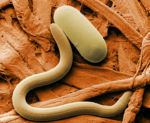Difference between revisions of "Nematode Life Cycle"
Jump to navigation
Jump to search
| Line 10: | Line 10: | ||
*NOTE: we use the typical '''strongyle''' egg to provide us with a yard-stick for comparing sizes. A "large egg", for example, means larger than a strongyle egg. A typical strongyle egg is approximately '''80µm''' long | *NOTE: we use the typical '''strongyle''' egg to provide us with a yard-stick for comparing sizes. A "large egg", for example, means larger than a strongyle egg. A typical strongyle egg is approximately '''80µm''' long | ||
[[Category:Nematodes]] | [[Category:Nematodes]] | ||
| − | [[Category:To_Do_- | + | [[Category:To_Do_-_Max]] |
Revision as of 22:19, 13 July 2010
General Life-Cycle
- The basic life-cycle is very simple:
- egg → L1 → L2 → L3 → L4 → adult
- With a moult in between each larval stage
- But there are many variations on this theme
Nematode Eggs
- These vary greatly in appearance and are very useful for diagnosis as they can often be detected and counted in faecal samples
- NOTE: we use the typical strongyle egg to provide us with a yard-stick for comparing sizes. A "large egg", for example, means larger than a strongyle egg. A typical strongyle egg is approximately 80µm long
